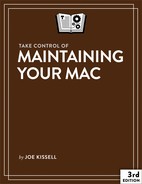New Releases of macOS
Since 2013, Apple has maintained a September/October shipping schedule for new versions of macOS (formerly known as OS X, and before that as Mac OS X). All indications are that Apple plans to continue this schedule for the foreseeable future. I’d like to share some advice you should follow whenever Apple releases a major new version of macOS.
Buy Take Control of Upgrading to…
When Apple released Mac OS X 10.3 Panther back in 2003, I wrote Take Control of Upgrading to Panther, which walked readers through every step of the upgrading process. That book was a runaway hit, and for every release of OS X since then, I’ve written a new Take Control of Upgrading to… book that covers all the important changes to be aware of, gotchas to avoid, and precautionary steps to take when upgrading. I write these books based on extensive testing and dozens of installations on numerous test machines.
My most recent book in this series is Take Control of Upgrading to Mojave, released in September 2018. I may not continue this custom forever, but it’s worth checking for a new Upgrading book when the next version of macOS appears.
So, why should you pay for and bother to read a book about how to upgrade macOS? Isn’t it just a matter of downloading an installer and clicking a button? If only it were so. Every upgrade of macOS brings with it not just new features and fixes but new hardware and software incompatibilities, installer oddities, and confusing custom installation options. My Upgrading books will help you understand each installation option, keep your data safe, and make the upgrade as stress-free as possible; you can find them (and many other titles by top Mac authors) at Take Control Books.
Make a Fresh Bootable Backup
Before performing any major system upgrade, be sure to update the duplicate of your startup drive or, better yet, make a new one from scratch in addition to your regularly updated duplicate. System upgrades can cause many things to go wrong—for example, you may find that some of your mission-critical software has problems after the upgrade—and you’ll appreciate the security of knowing you can restore your system to its previous state if a problem occurs.
Upgrade
Some people habitually wait until the first or second minor update after a major macOS release before taking the plunge, whether to give Apple time to work out any early bugs, to give developers time to update their apps for compatibility, or to see how other people like it before committing themselves. Others feel so nervous about upgrading that they wait until it’s nearly time for the next major version to be released! But the longer you put off upgrading, the longer you’ll go without useful new features, not to mention important bug fixes and security improvements.
I’m an early adopter, and although I’ve experienced my share of minor hurdles, I’ve never regretted a decision to upgrade immediately. You may, however, want to delay an upgrade if you’re in the middle of a project and can’t afford any downtime, if you rely heavily on an app that has not yet been updated to work under the new system, or if you expect to buy a new Mac in the near future (which will, of course, include the latest version of macOS).
